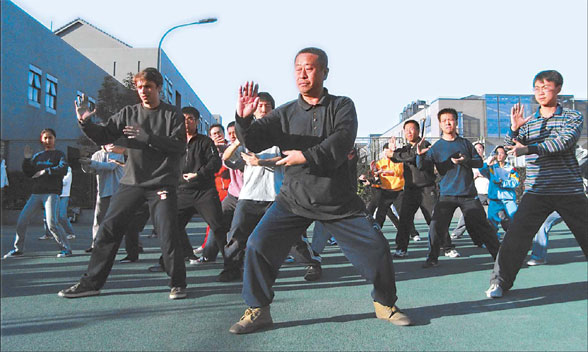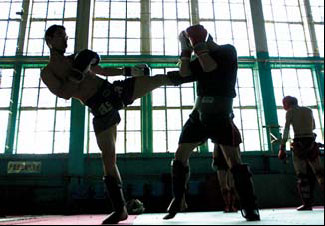Skills that thrill
|
Beijing subway technician Ma Laiwang (center) has volunteered to teach students from Peking University and Chinese Academy of Sciences Chen Style taichi for over 20 years. The 54-year-old began learning kungfu at 6 and has been widely recognized as a kungfu master. Zhu Linyong |
Wang Hexin, a sales manager at a medical store, is widely considered a veteran wushu practitioner in Beijing, trained in such kungfu styles as Mei Hua Quan, Da Cheng Quan, and Zhu Sha Zhang.
It is hard to imagine that back in the early 1970s when he was a small child, Wang was unable to stand after a botched medical treatment.
"My parents were deeply worried," recalls Wang, the only son in the rural family. Wang first began learning Chinese kungfu as therapy for his legs from some older villagers in the 1970s. After strenuous training, he managed to stand up, walk and even run, much to the delight of his parents.
"It is wushu that helped me gain self-confidence," says Wang who continued to learn from well-known kungfu masters such as Yu Yongnian in Beijing and Yang Yong in Wuhan, Hubei province.
Today, the 39-year-old spends most of his spare time, teaching teenagers in his home in Tongzhou district basic kungfu skills.
"Wushu is an indispensable part of my life," says Wang, a certified doctor of traditional Chinese medicine.
Wang is not alone in his passion for the centuries-old Chinese martial arts.
Liu Hongyi, 28, who works for a gifts company in Beijing, has invested most of his savings in learning and studying Chinese wushu over the past decade.
To get close to kungfu masters in the Chinese capital, he left his home city of Jixi in Heilongjiang province and attended many wushu training courses. In his small, rented apartment in Beijing, Liu has built an impressive stock of wushu books and DVDs. "Wushu is my only hobby," Liu says.
Official statistics show that China has at least 91 "kungfu counties and cities", each with over 100,000 practitioners of various wushu styles.
Wang and Liu are among the millions of people today who continue to practice wushu in and outside China, says Zhang Quanhai, a wushu practitioner and scholar with the Renmin University of China.
"Life changes and times change. But the ancient martial arts continue to be relevant," Zhang says.
Take taichi for example. In the 1950s, the Chinese government organized a group of kungfu masters and sports experts to simplify and standardize Chinese wushu styles.
As a result, a roster of simplified wushu forms (tao lu) featuring a series of postures and gestures were introduced to maintain good health, according to Zhang.
A recent report by China Central Television indicates there are about 100 million people worldwide practicing Chinese taichi, arguably the most popular and best-known Chinese wushu style today.
In provinces where wushu is part of the local tradition, such as Shandong and Henan provinces, the number of wushu enthusiasts run into the millions, says Li Xianwei, deputy head of Shandong Laizhou Wushu Training Center, a privately owned wushu school.
At present, China has reportedly over 15,000 registered wushu schools, besides the numerous private coaching centers.
|
A growing number of young Chinese are learning wushu as well as imported, combatant sports such as taekwondo, karate and muay Thai. Wang Jing |
The number was much larger back in the 1980s when kungfu movies and TV drama series such as Shaolin Temple starring Jet Li and Drunken Kungfu Master starring Jackie Chan were popular among young people, fueling a strong interest in ancient Chinese martial arts, says Li whose training center has at least 1,000 students aged between 5 and 18.
Since its establishment in July 1992, his center has trained over 12,000 students, including some from other countries and regions.
Over the past few years, the center has opened 10 branches in countries such as France, Spain, South Africa, and the United States, providing all kinds of traditional wushu courses for foreigners.
For a better and quicker grasp of Chinese kungfu, some foreigners have come to China, seeking apprenticeships under kungfu masters.
Among the most sought-after destinations are the "hometown of Chen- Style Taichi" - Chenjiagou, in Wenxian county and Tagou in Dengfeng county where Shaolin wushu courses are available to foreigners.
Websites and on-line communities about kungfu have increased dramatically in recent years.
"Websites such as YouTube have plenty of Chinese kungfu-related materials," says Tim Grose, an American student who has converted from a veteran karate practitioner to a Chinese kungfu learner.
"It seems that Chinese wushu is drawing increasing attention," says Lumbroso Florent, a 23-years-old French student, learning wushu and Chinese at the Beijing Chemical University.
"Chinese wushu is more culture and philosophy than fists, kicks, elbows and shouts," he says.
"Peace, inner peace, is at the core of wushu and that's why I am fascinated with it," he adds.
Indeed, wushu is gaining a high profile among the general public, especially with the upcoming Beijing 2008 wushu tournament, says Zou Guojun, CEO of Shenghua International Martial Club, an influential professional organization that specializes in training and teaching martial arts, taekwondo and kickboxing in China.
The tournament is scheduled to open from Aug 21-24 on the sidelines of the Beijing Olympic Games.
Also, in October, Harbin will play host to the National Kungfu Challenge.
"Although wushu is not among the 28 sports to be held during the Beijing Olympic Games, it will definitely become popular among visitors to the Games," says Zou.
But concerns over the future of the traditional martial art remain. Some worry that a growing number of young people are being drawn to such foreign sports and martial arts styles as taekwondo, judo, karate and muay Thai.
"These imported martial arts styles are attractive to some young Chinese fond of trendy, popular culture introduced to Chinese people through movies, songs, dance and lifestyle," says Ding Xin, a post-graduate student with Peking University.
But for Ding, it is time to embrace Chinese wushu.
"With China's growing international influence, we have an increasingly stronger feeling for our own culture," Ding says.
(China Daily 05/07/2008 page18)
















